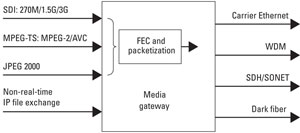Video networks
The broadcast business is changing. Smaller operators have consolidated into larger media groups. Larger media companies have become global. All this linking of broadcast operations into regional and global networks would not be possible without video networks.
Last century, terrestrial real-time connections used expensive long-haul coaxial and microwave circuits, with satellite used for transcontinental and transoceanic hops. Over the last decade, video is being transported more and more over fiber networks, leveraging the falling cost of fiber connections. Satellite still has advantages where fiber connections may not be readily available, especially for occasional use.
HD-SDI over coax is limited to short runs in the order of 100m. Even within a broadcast campus, fiber has become necessary for interbuilding connections. For connections of any distance, fiber has become the favored physical layer.
With videotape reaching obsolescence, non-real-time content distribution by the transport of files via fiber networks is replacing physical movement of tapes. One of the big advantages of file-based operations is that files can be transferred over regular IT networks. As fiber networks have spread across the world, it has become attractive to use them for video transport, supplanting and replacing satellite networks. Using regular telco networks, broadcasters can move content as files in non-real time or as streams in real time.
Telcos
Fiber networks are built to telco standards, which have evolved from methods to multiplex many voice circuits together for telephony and from data delivery networks. Real-time video transport has some special requirements, which in the past have been catered for by custom systems that add cost.
The public Internet represents a large proportion of fiber traffic, with private traffic from enterprise users — especially the financial sector — making up most of the rest. As broadcasters represent a very small proportion of overall traffic, they are not a priority for many operators, and they may not be inclined to offer special products and services to meet broadcasters’ needs. With many telcos now offering GigE connections at a low cost, it is advantageous for broadcasters to use that interface rather than look for video-specific circuits.
The professional video industry's #1 source for news, trends and product and tech information. Sign up below.
The service offerings from fiber network operators vary from country to country. It depends on the extent of the deregulation of the telecommunications systems and how much investment has gone into new networks.
As fiber costs fall, broadcasters can afford to use more metro and long-haul connections. This trend will aid the drive to globalization in the media business.
The network
Over the decades, telcos have offered many carriers for video data: frame relay, ATM, PDH and SDH/SONET. This complexity is being radically simplified with telcos moving to Carrier Ethernet over optical networks. The migration will take time as older systems are amortized. In the intervening period, a hybrid of systems will coexist, packet and circuit switched.

Table 1. Typical data rates needed for HD distribution. Note: Excludes overhead for error correction.
Traditional broadcast networks were constructed with point-to-point circuits like the studio-transmitter link or links to regional offices. One popular format was the 34Mb/s E3 circuit (45Mb/s T3 in the U.S.). Standard-definition composite video was compressed to match the available bandwidth. With the migration to HD, such circuit bandwidths were inadequate for contribution circuits. (See Table 1.)
E3 and T3 form part of the plesio-synchronous hierarchy (PDH), a system developed primarily for voice circuits. New standards in a synchronous hierarchy, SONET/SDH, have replaced PDH and offer the higher data rates needed for HD, starting at 155Mb/s (STM-1).
Depending on the quality required and the cost of the circuit, video can be transmitted uncompressed or compressed. Typically, contribution circuits use MPEG-2 or JPEG 2000.
Fiber
As telcos move to higher and higher data rates, fiber has become the primary transport medium. Telcos have laid extensive metro networks (classed as less than 200km) in cities, with long-haul fiber connecting cities across a country or continents.
Fiber operators can supply dark fiber point-to-point links to connect broadcast premises in metro networks. These can be terminated with equipment available from several broadcast equipment suppliers and used to carry SDI/AES circuits between the premises. Such systems are secure but will need dual diverse-routed fibers to protect against cable breaks.
For longer distances, or where private fiber is not an option, the video and audio data must be interfaced to conventional telco formats like SDH. This system combines many circuits over one fiber using time division multiplexing (TDM), through pipes and switches (which may well remultiplex the circuits) to the destination. This system has grown organically as a means to carry many voice circuits between exchanges, and regular data (video or computer) can be multiplexed in with the voice circuits.
Packet switching
The alternative method (with roots in frame relay, ATM and the Internet) is to use packet switching. Rather than setting up a dedicated circuit, packets find their way through the network. Network routers read information in the header of a packet to determine the route for the next hop and forward the packets appropriately.
With telcos handling more and more data traffic as opposed to voice (telephony), packet switching offered a more flexible way forward. SDH circuits can be used to carry ATM cells as well as Ethernet frames. Packet networks allow telcos to use techniques like statistical multiplexing, dynamic bandwidth allocation and quality of service (QoS) management to get better utilization of their networks.
Packet switching is inherently self-healing. If a route is congested, the routers will divert packets over an alternate path. However, packet switching is not without its drawbacks, notably packet loss and jitter. Packets can also arrive out of sequence. For normal office data, transport control protocol (TCP) is used to manage packet loss by retransmission of lost packets. For the huge data streams of real-time video, this process is not appropriate.
Adding fiber capacity
As telcos looked to drive down the cost per bit of connections, the technique of wavelength division multiplexing (WDM) was developed. Each optical carrier (wavelength) can carry 2.5Gb/s data, with 10Gb/s and 40Gb/s systems also possible. WDM uses different laser frequencies so that more than one channel can be transmitted over a fiber. The first system could combine up to eight different wavelengths, and is now called coarse WDM (CWDM). Later improvements in technology enabled 100 different wavelengths or more to be used. This is referred to as dense WDM (DWDM).
For fiber circuits, the main cost is getting access to property to lay cables, and for the installation — digging the trenches. The cost of the fiber is a small proportion. WDM allows the capacity of existing fibers to be instantly increased at a marginal cost.
SDH/SONET is being replaced with DWDM optical transport networks (OTN) and Carrier Ethernet. An OTN comprises the fiber links plus terminal equipment to multiplex, route and manage the data signals.
Carrier Ethernet is a development of the regular Ethernet used to build LANs and WANs. It can be used as an alternative to SDH/SONET, or carried over SDH/SONET as a point-to-point circuit. It provides a good solution for converged voice, date and video circuits. Native Carrier Ethernet adds services like QoS and service management over the regular Ethernet technology of LANs. The Carrier Ethernet networks can detect and heal faults, and allow operators to offer SLAs that meet performance parameters like packet loss. Carrier Ethernet is offered as standardized services, including point-to-point (E-Line) and multipoint-to-multipoint (E-LAN).
With the advent of Carrier Ethernet, the interface to a network is now more likely to be a 1Gb/s or 10Gb/s Ethernet port. A 1Gb/s circuit can carry three 270Mb/s circuits; 10GigE can carry six 1.5Gb/s HD circuits.
SMPTE 2022
In order to stream video over IP, a scheme was needed that could counter the issues of transmission errors. The Video Services Forum (VSF) and SMPTE developed a group of standards to define such a scheme, SMPTE 2022.
First video data must first be mapped into IP packets. In the case of constant bit rate MPEG-2, this is detailed in SMPTE 2022-2. The video data is encapsulated in Real-Time Protocol (RTP, IETF standard 3350), which deals with the transfer of real-time data. The datagrams use User Datagram Protocol (UDP) over IP, rather than the more common TCP/IP.
RTP, which deals with the transfer of real-time data, includes timestamps (for synchronization) and sequence numbers so that the receiver can restore out-of-order packets to the correct order.
Packet loss is managed through forward error correction (FEC). Redundant data is added to the video stream so that the receiver can detect and recover missing information. The downside of FEC is it adds to the overall data rate.
The initial standards defined the FEC and means of transmitting MPEG-2 video (2022-1). Variable-bit-rate MPEG-2 is covered in 2022-3 and 2022-4. Later work added an FEC standard and mapping for High Bit Rate Media Signals over IP Networks (HBRMT), including 270Mb/s, 1.5Gb/s and 3Gb/s video (SMPTE 2022-5, 2022-6). The standards do not detail JPEG 2000, but this is expected to be covered by a recommended practice from the VSF.
File transport
Several products now exist that manage the transport of video files over long-haul circuits. The vagaries of insecure FTP circuits are now replaced with encrypted (if needed) and fast links.
Application layer protocols like FTP run over TCP/IP. TCP was conceived back when office networks ran at 10Mb/s and remote access used dial-up modems running at tens of kilobits. The algorithms to manage congestion are just not suited to the networks of today. Several vendors now offer alternative transport control technology that can fully utilize the available bandwidth.

Figure 1. A media gateway integrates real-time and non-real-time video and audio traffic and formats for carriage over telco circuits.
Such data transport applications can be integrated as Web services in wider broadcast systems in order to provide automated deliver of files between workflow processes. (See Figure 1.) The wide area transfer of files is essential to the smooth operation of dispersed broadcast operations.
With many broadcasters leasing long-haul fiber connections for live video contribution and distribution links, spare capacity can be used for this non-real-time data exchange.
Summary
The introduction of Carrier Ethernet over fiber networks has lowered the cost per bit on metro and long-haul connections. This, in turn, opens up new possibilities for broadcasters. Group stations are able to consolidate operations into a central hub. Satellite stations can be operated from the hub as if they were on the next block. Sportscasters can provide the same quality of coverage with fewer staff on site. Many operations can remain at network HQ, with fiber connecting the remote venue with studio operations back at base. The 2012 Olympics saw many applications of fiber to save onsite operations costs.
Fiber also enables the mass transport of files from producer to distributor, cutting out the costs of tape transport. Directors and producers are no longer tied to the post house; remote collaboration can use a mix of live proxy viewing and file exchange to facilitate more efficient program production.
Video networks are helping the globalization of content provision and revolutionizing the offering to viewers from sportscasters. They underlie centralcasting operations. The affordability of video networks is enabling broadcasters to do more with less. The technology for video networks is driven by the video traffic over the World Wide Web and by the data transport needs of enterprise corporations. Broadcasters can take advantage of this low-cost connectivity to offer new services and streamline workflows across multiple sites.
—David Austerberry is editor of the world edition of Broadcast Engineering.
